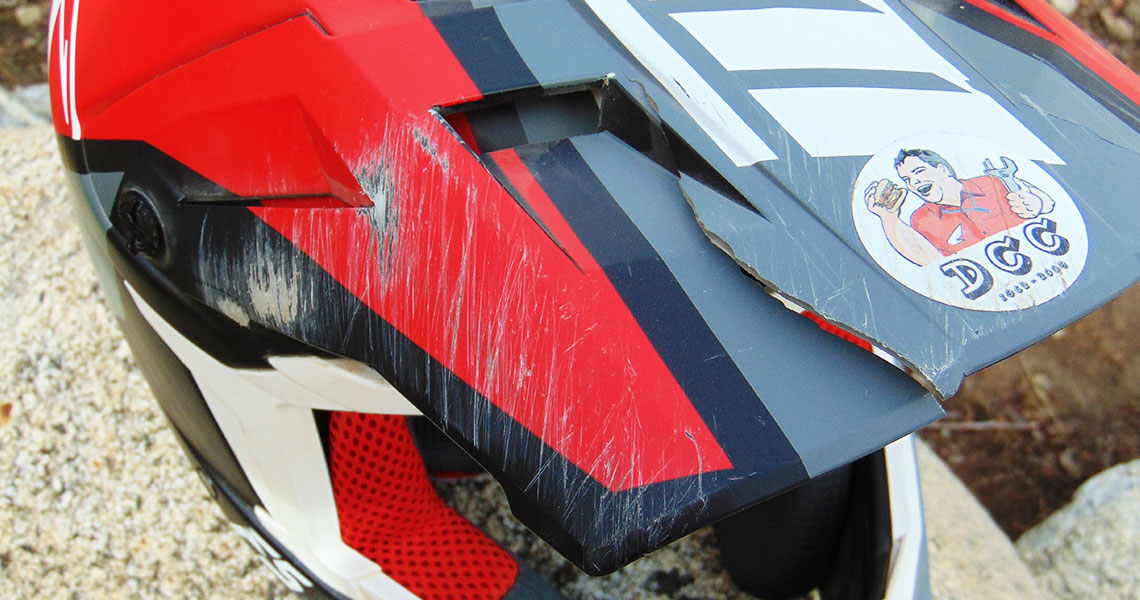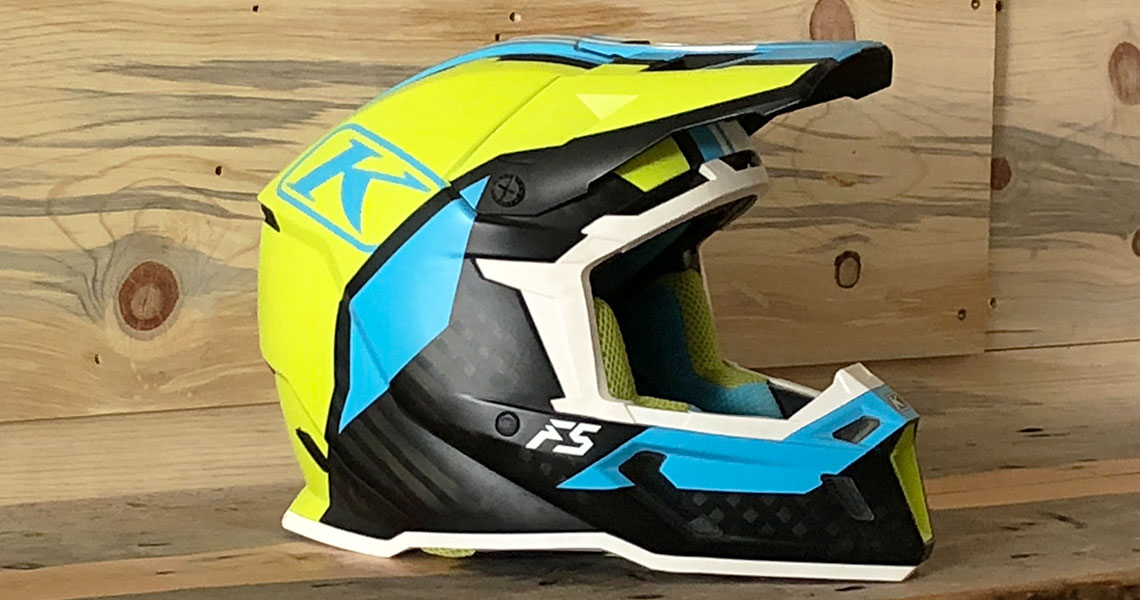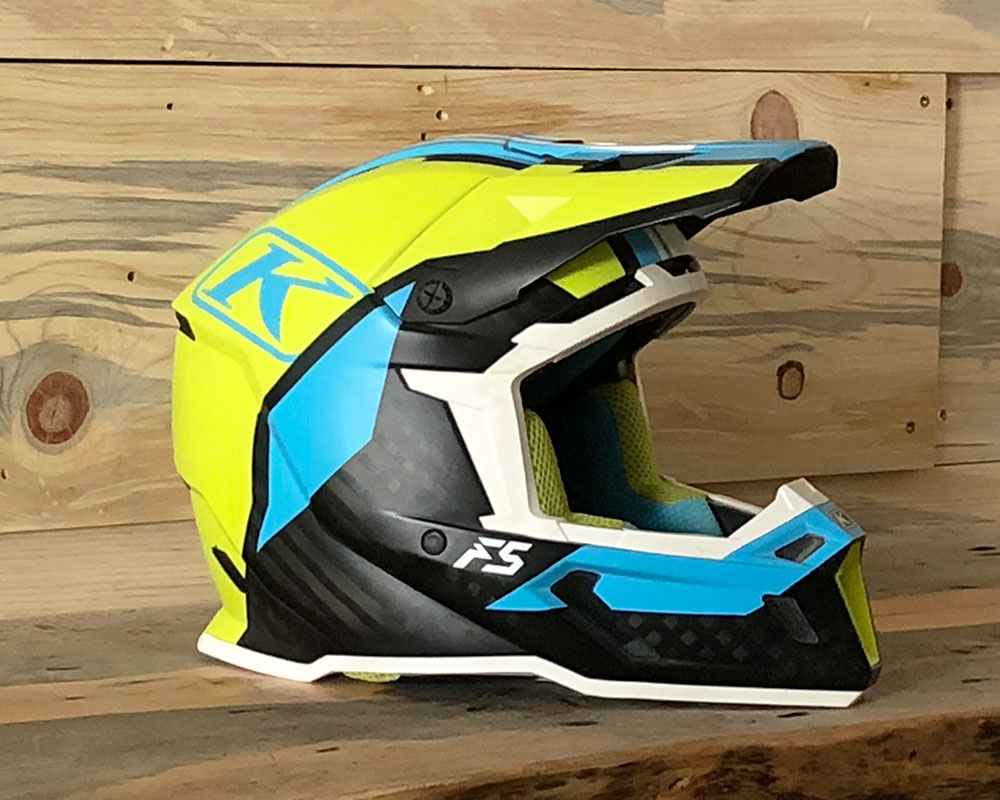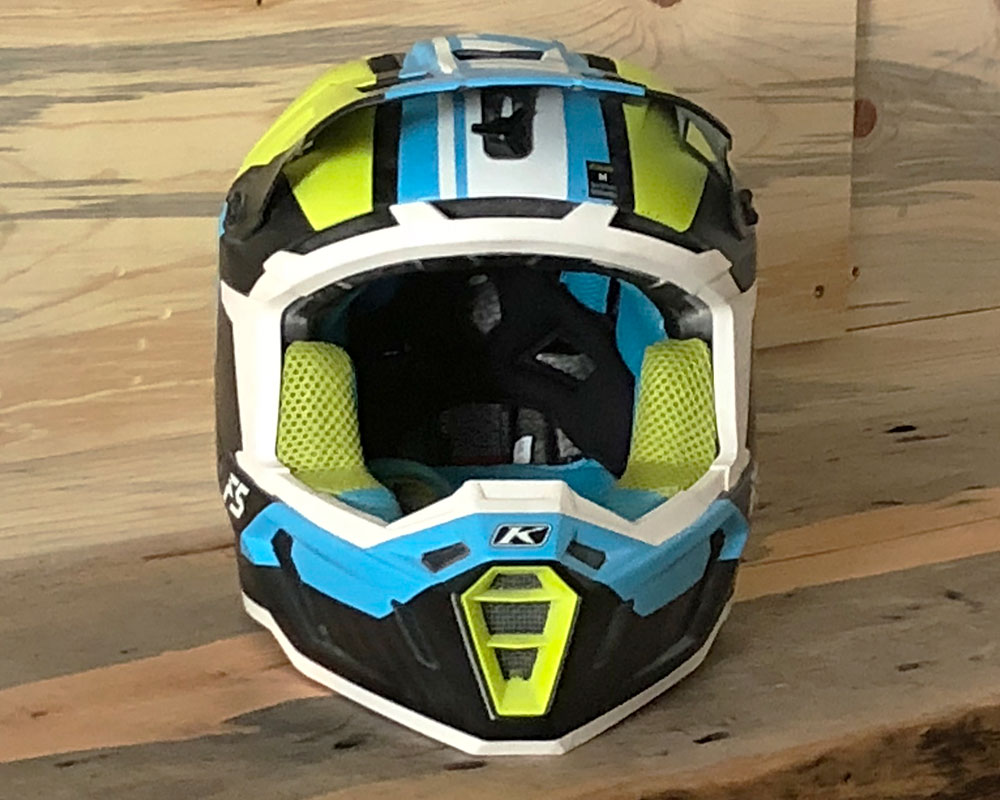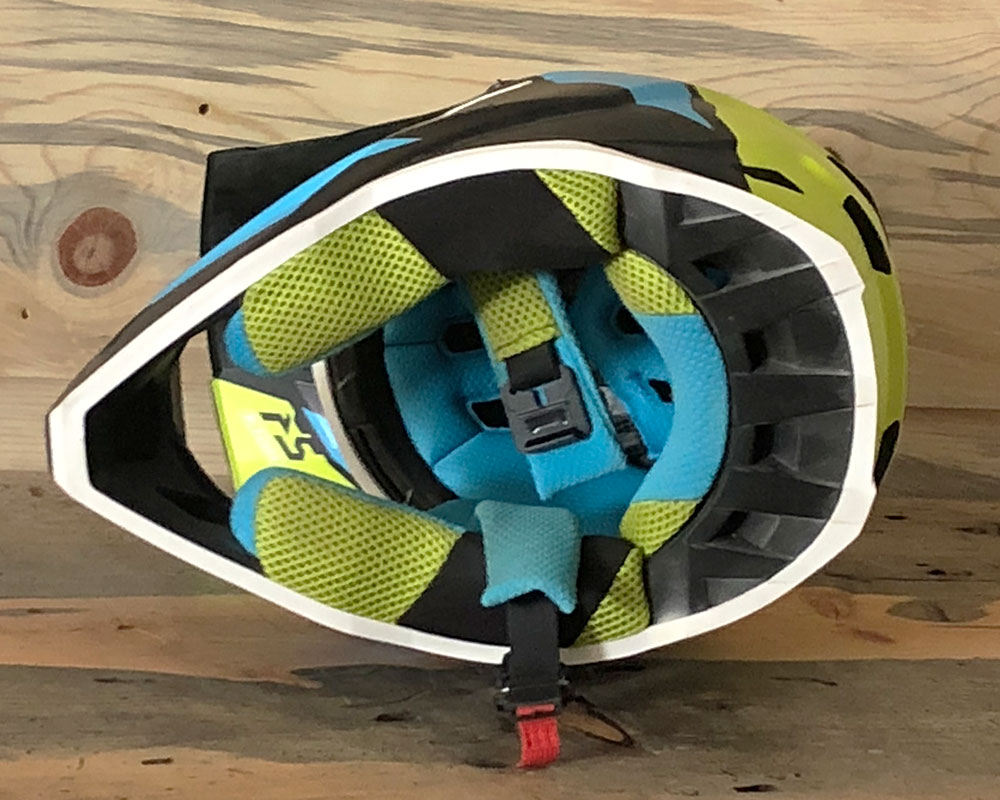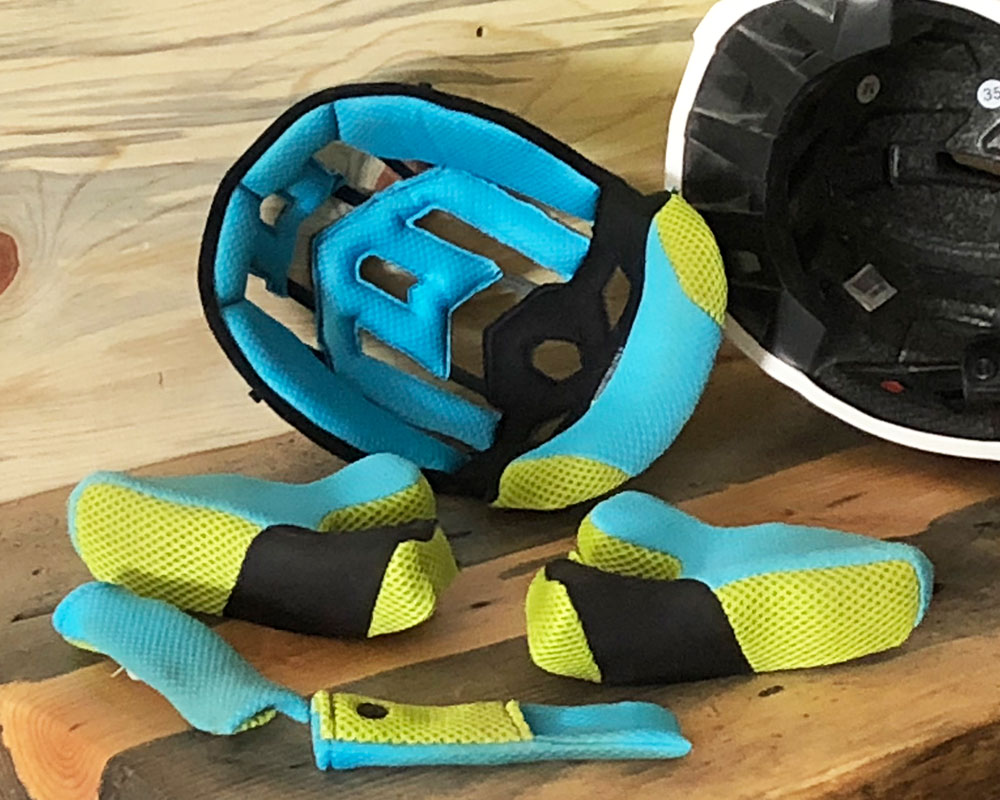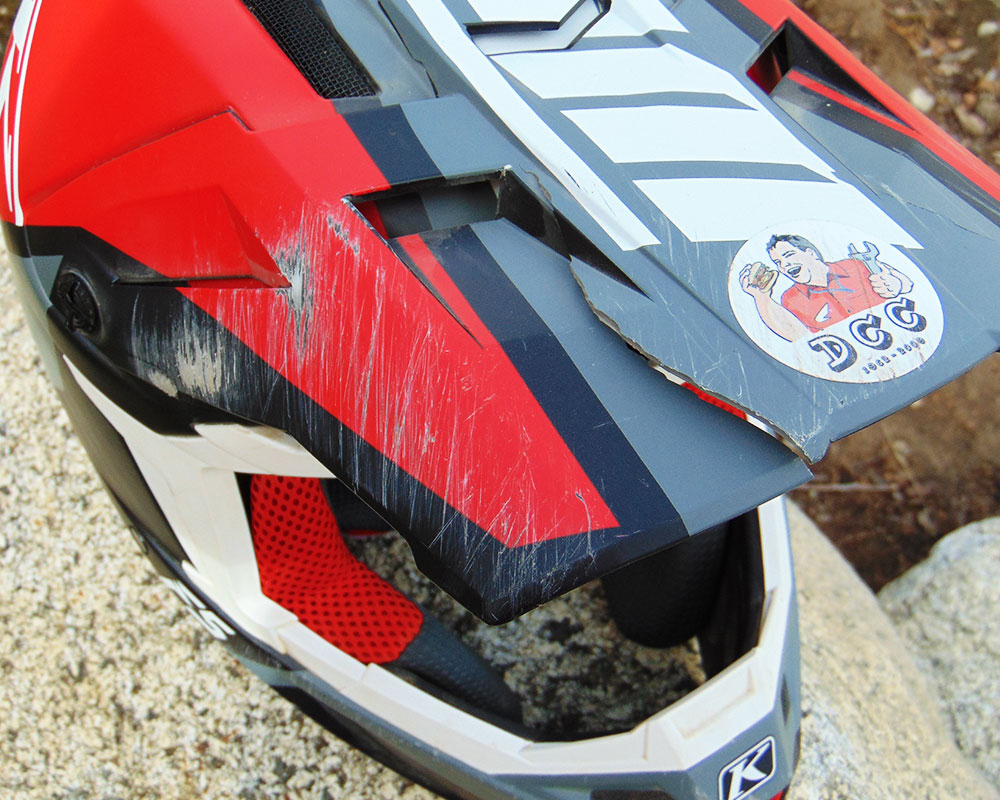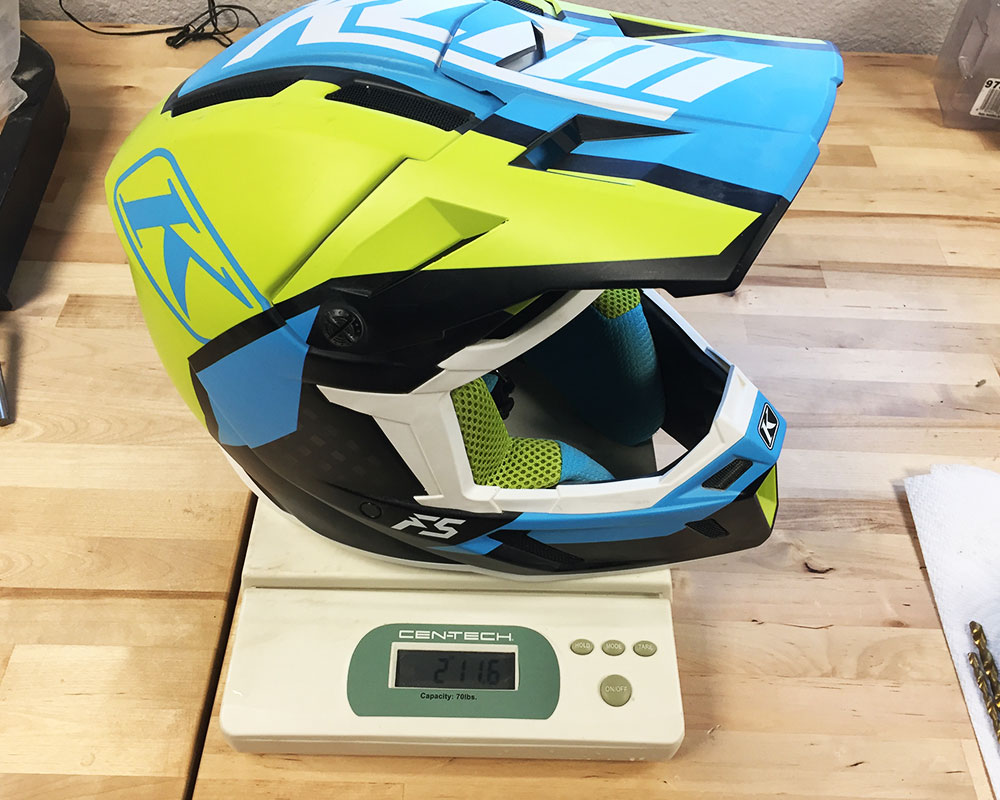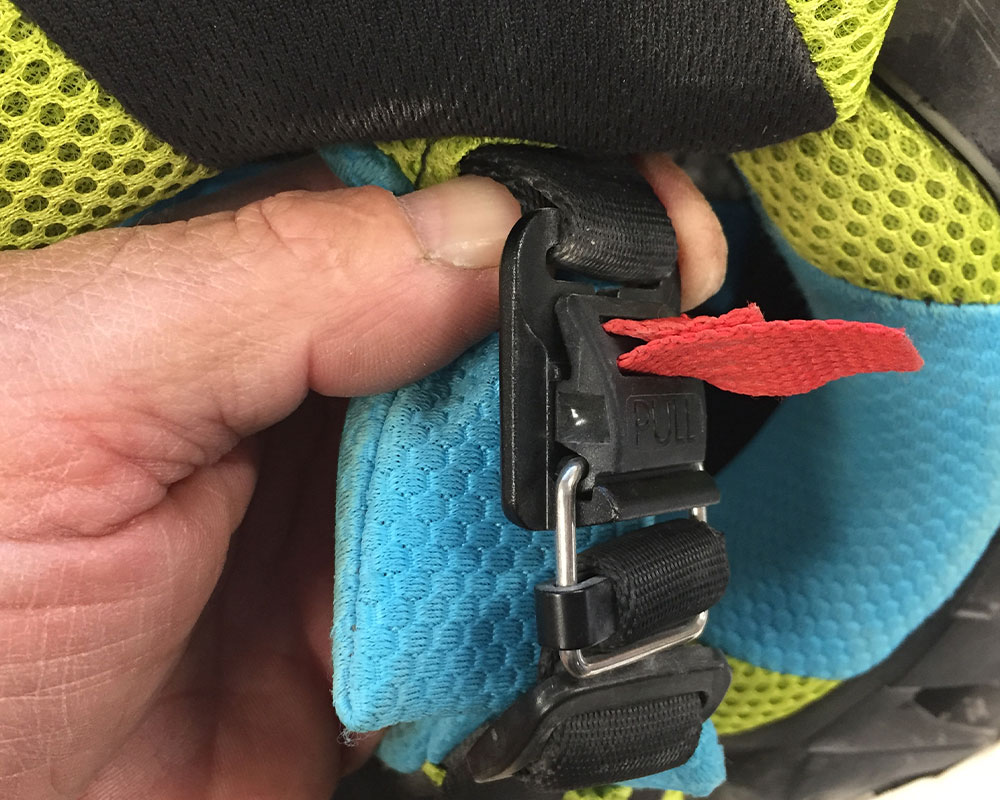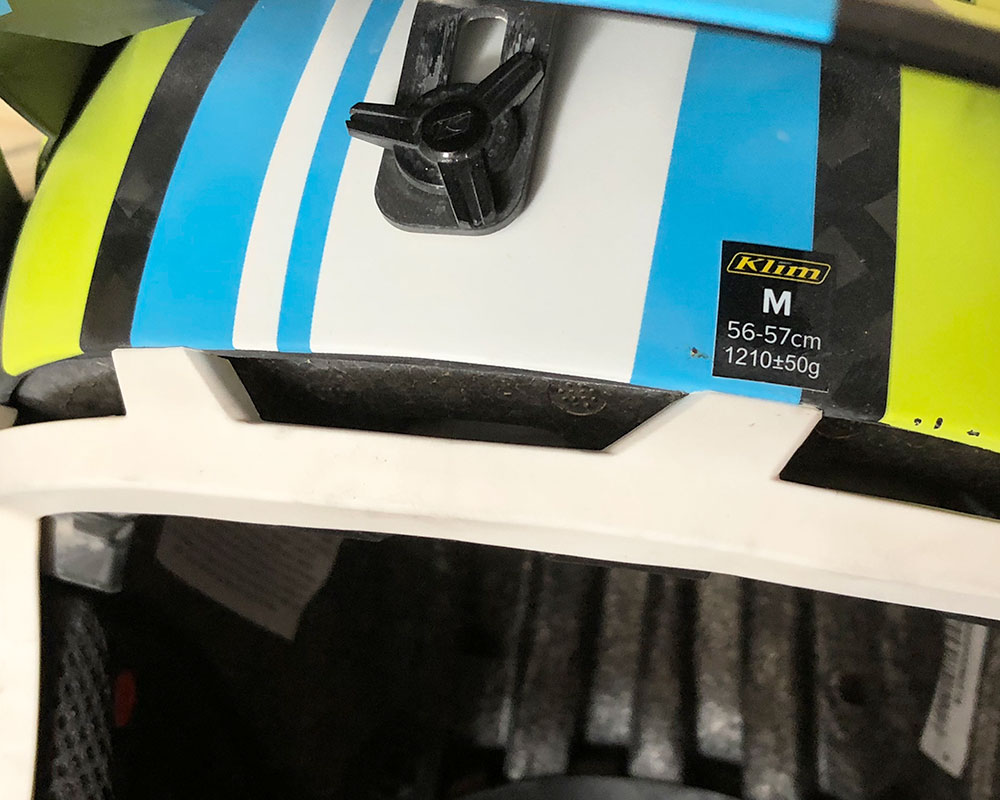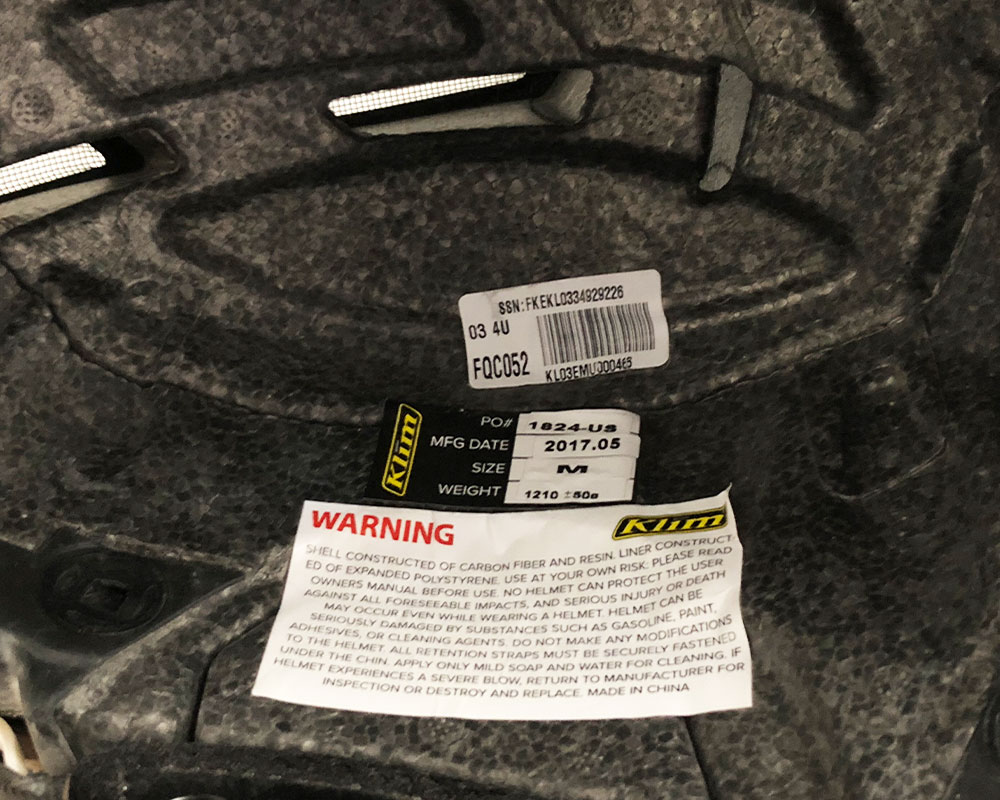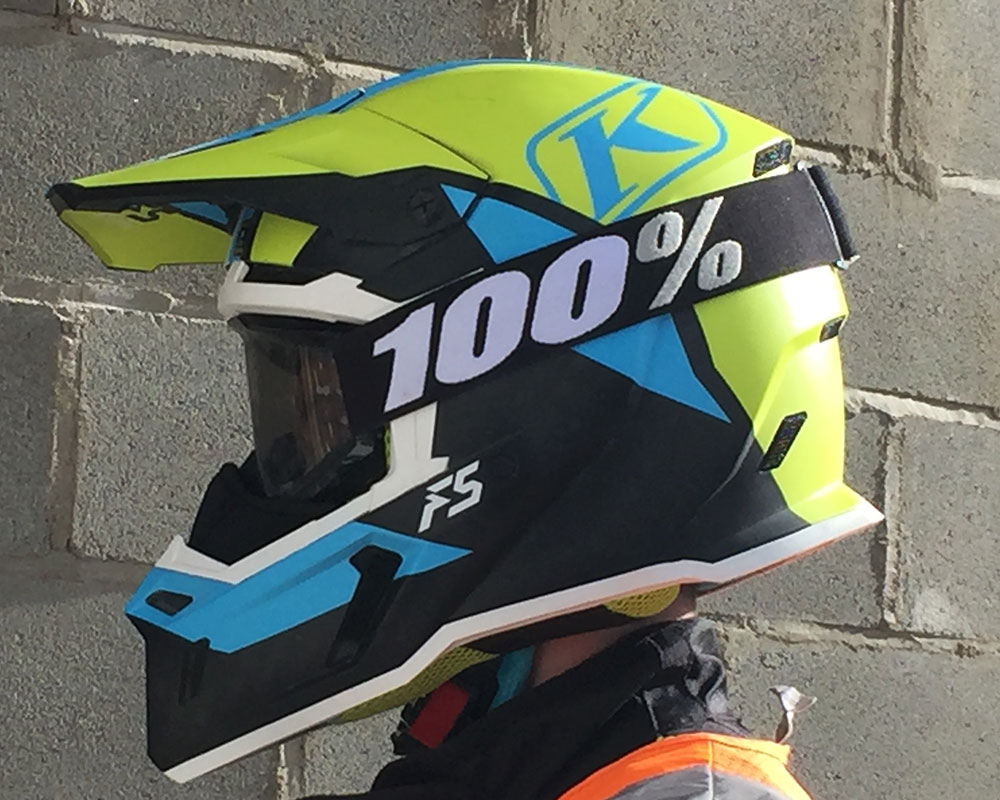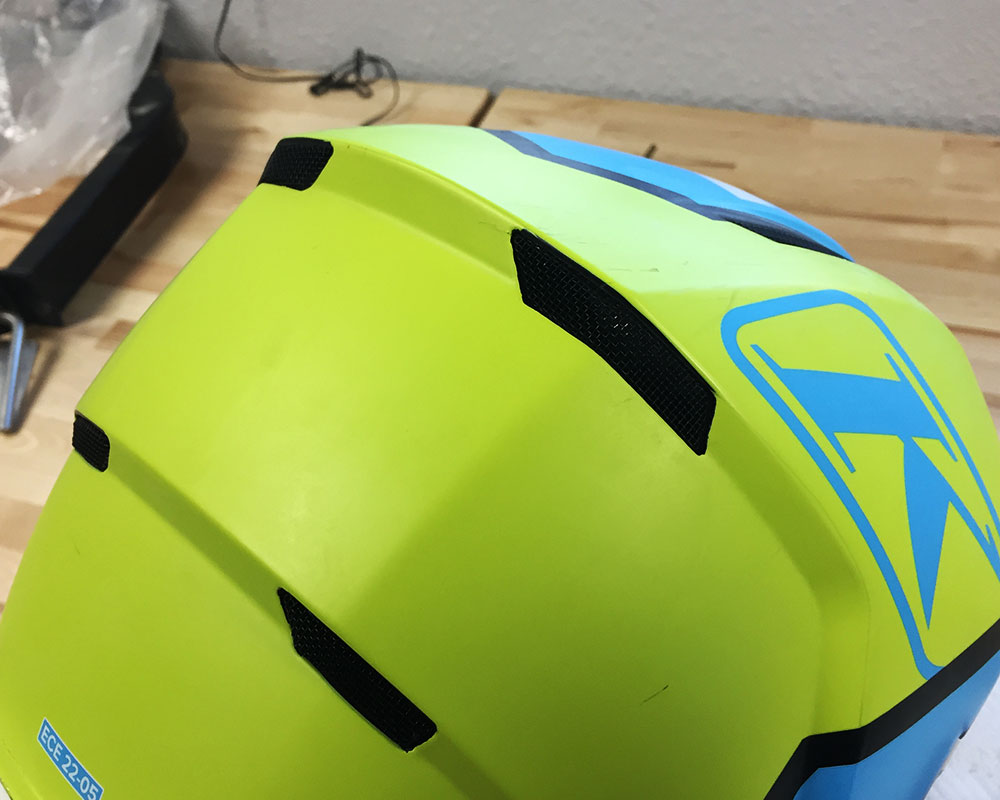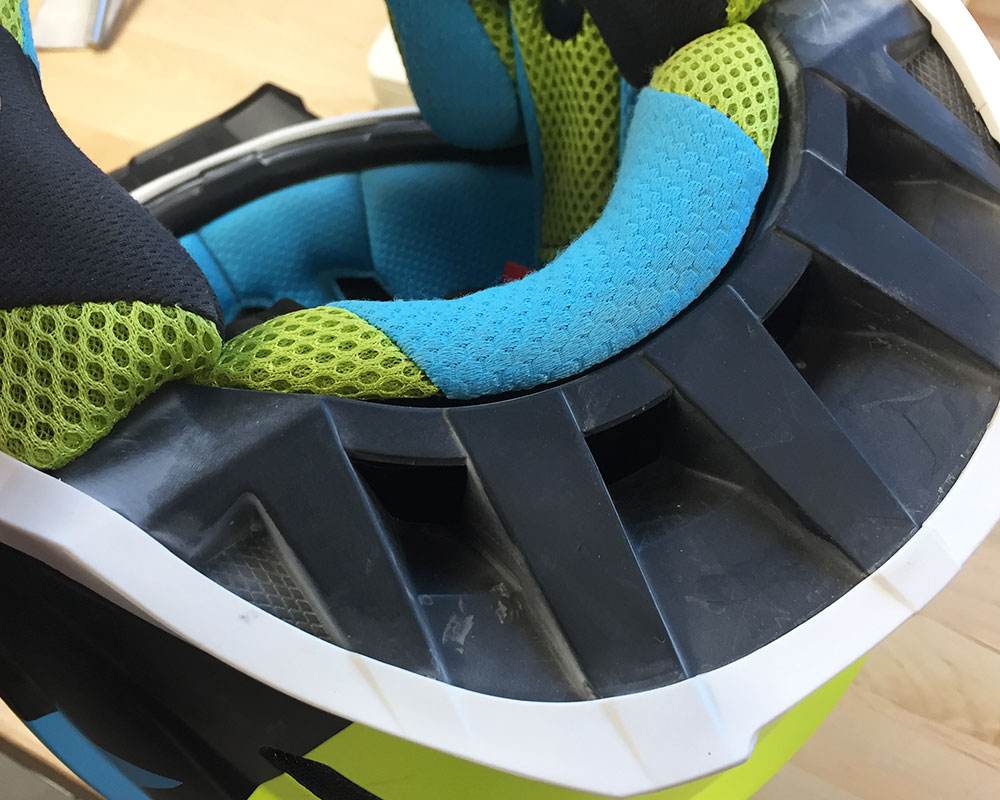Klim F5 Helmet
Company: Klim
Price: $499.99
- Very lightweight.
- Extremely comfortable and well ventilated
- Easy Fidlock chinstrap.
- If you’re a skinny guy like me your head looks enormous.
- Not D.O.T. approved. (Might effect your dual-sport ride.)
- Dirt gets in the vents, especially sand.
What it is
- Klim's top of the line ventilated helmet.
The Klim F5 helmet is made with a carbon fiber shell giving it the super lightweight feel. To go with the carbon fiber shell, Klim used a three density EPS (expanded polystyrene). This is basically three different sections of EPS that are all different densities to give the most protection possible at the lightest weight.
This F5 features 18 intakes and 8 exhaust vents. The plumbing inside the shell is designed to help with the direction of airflow. The exhaust vents are meant to help with the escape of hot air inside the helmet at low speeds eliminating the need for high speeds to experience the airflow. Klim really wanted to focus on keeping a rider’s head cool and dry with a Drylex comfort liner that is soft and wicks moisture. Unlike the older klim helmets that used scoops, this one does not. So the days of hooking on branches and getting caught are gone.
With all this ventilation winter time riding and how waterproof the helmet would be was a big question. Not to worry. To combat this Klim included in the helmet bag, a Gore Tex Windstopper liner which is easily applied in between the liner and the helmet. It’s a cloth-like material that is waterproof as well. This windstopper is intended to shut off all the vents allowing your head to stay warm and keep your head dry.
The windscreen is another feature the F5 offers. To attach it you simply take out the cheek pads, which are held in place by snaps, and snap in the windscreen in the same area as the cheek pads, and then snap the cheek pads back into place.
A very unique feature Klim integrated into the F5 is the Fidlock magnetic chinstrap. The magnet within the Fidlock system is there simply to guide the strap into place. It’s held in place mechanically by a locking mechanism. This is meant to make taking the helmet on and off quick and easy. The F5 is ECE certified, but not DOT so technically you can not wear it when riding on the street.
For more info see: https://www.klim.com/off-road/mens/Helmets
How it works
- It flows so much air that very few even come close.
- Aside from the small easy pull strap I could not find any other way to disconnect the strap.
- The Klim F5 looks great.
The first thing I noticed on the F5 was how light it is. When I picked it up I could instantly tell. Some helmets that don’t have that lightweight feel and when worn put a slight strain on my neck when I lift my head, or turn it side to side. However the F5 did none of that. It was almost as if nothing was on my head. The bottom of the cheek pads form under your jawbone which helps keep the helmet in place for a snug fit on most heads. If you get claustrophobic easily the cheek pads may be an issue for you.
Aside from safety, comfort is my next priority in a helmet. All-day rides with helmets that squeeze your head in ways they shouldn’t are definitely no way to go. The F5 has a very comfortable shape while still staying snug, our more experienced testers called it a slightly oval shape which is a more common head shape in the US. Although, some of my riding buddies found the helmet to be uncomfortable. Mostly the cheek pads were tight for them.
The ventilation of the helmet adds to the comfort as well. You will feel as if you have never worn a truly vented helmet after wearing this one. It flows so much air that very few even come close. The 18 intake ports and 8 exhaust vents worked amazing. There was so much airflow in the helmet and around your head it’s almost as if you aren’t wearing a helmet. High speeds were not a necessity for the ventilation to work, the 8 exhaust vents allowed for hot air to escape keeping my head cool which allowed me to focus more on my riding and kept me less worried about how hot I was. This also prevented me from getting tired so quickly. The only downfall with this system is this, the channels and veins in the cushioning to allow for the ventilation had a tendency to pull slightly on my hair. Just enough to bug me and take the helmet off to adjust it, but not so much it was painful. The also let a fair amount of dirt in, so getting roosted leaves dirt inside the helmet, even in the back.
The Gore Tex liner did exactly what Klim said it would do. Riding with it placed inside the helmet I could not feel any airflow at all. It also made it significantly warmer inside the helmet making it perfect for very cold situations. To test the water proof factor I put the helmet on and dumped water on my head. Believe it or not this piece of cloth somehow kept my head dry. It still baffles me on how well it works.
The windscreen was simple to use. Even with how big the inner flap-like device was it didn’t look terrible. The only problem I had with the windscreen is my 100% goggles had a tendency to fog up. Not to a point to where I couldn’t see, but just enough to annoy me. However, with a smaller pair of goggles this issue was avoided. This feature is definitely a must for below freezing temperatures and comes from Klim’s extensive snow machine riding gear knowledge.
The liner was simple enough to remove for washing it and the helmet. The cheek pads had three snaps each that came off with little effort, and went back into place easy as well due to the design of the pads and helmet. They form really well together. The liner was a little more difficult to remove. It too had four simple snaps that are kind of a pain to get off, but nothing to stress over. They were also easy enough to get back into place.
Attachment and detachment of the visor is quick and easy, no tools needed! There are three total screws, one on each side of the visor and one in the middle. The two screws on either side tighten and loosen easily by hand and do not need to be cranked down. The middle screw just needs to be snug so they all work together to allow the visor to be adjusted to the riders personal needs. In the fancy Klim bag the F5 comes with there is extra hardware and a spare visor in case things get a little too wild on the trail.
The Fidlock chinstrap system is a little different than traditional means. I was a little hesitant about the chinstrap at first. How well can a little magnet really hold something in place? Aside from the small easy pull strap I could not find any other way to disconnect the strap. It does take a few practice runs to learn the placement to get it to snap together, but once you’ve learned it forget the old way. It is like an electric starter for your helmet.
Now for durability. Overall, I feel the F5 holds itself together well. The only true issues I’ve found have to do with the paint. Around the edges of the helmet you can see where slight bits of paint have fallen off or chipped away. However, this is not noticeable unless you really look closely. I did a trail ride in the mountains with this helmet. The whole time I felt like I was being attacked by trees. The helmet suffered only minor paint scuffs that could be almost completely washed away with a wet rag. There did not seem to be any deep gouges, or scratches to the base layer. Very impressive for the beating the trees and myself gave it.
The Klim F5 looks great. It has sleek lines and edges and kind of a mean look to it. The only downfall is I’m a skinny guy and it did make my head look a little bigger than I would’ve liked. Otherwise, I think it is a great looking helmet.
Usually with helmet tests we are lucky enough to not have fully tested the product. Meaning crashing and really testing the protection of the lid. Well this time was different and we got a full-on head smasher that resulted in a knocked out rider. Judging by the helmet and the crash scene the helmet absolutely did its job. We typically assume this is the case with most helmets based on the safety tests they are certified with, but in this instance we were satisfied with the results, all things considered. The helmet did its job and it is now retired. The internal foam was compromised so it is no longer safe to wear, like on any helmet after a good impact even though the shell was still intact.
Typically we rely and trust the helmet testing standards because we know and understand what they represent. The Klim F5 meets ECE Only and is not D.O.T. certified so this is something to consider if you are a Dual Sport rider needing the DOT compliance. As always and with any helmet, the first thing a helmet needs to do is fit properly. Then the second most important thing is weight (the lighter the better because you can’t alter physics) as long as the helmet meets the testing criteria you feel your head needs.
The F5 is not inexpensive and it is priced up there with other high end helmets. And to that, it competes with any of them as far as we are concerned. It hits home runs in being the most vented helmet out there and it is very light (2lb. 11oz. for Medium), it is built tough and we actually prefer the ECE safety standard of all standards that are out there for most off-road riding. And once you get use to it, the buckle system will make you hate the older D-ring types. Overall, Klim’s F5 is definitely worth the $500. If you’re not one to spend a lot on gear, make this something you do spend a little more than normal on. It will be worth it.
Notes from Ray Conway on Crash Test:
I was on a multiday industry trailride and had just received a new Klim F-5 Helmet to try out on this ride. I was talking to one of the Klim reps on the morning of the first day and he asked me about the Fidlock system. I said, “I guess we will find out when someone crashes in this helmet.” The first day of the ride went by with no problems, and after a 250 mile day of riding I agree with all the comments in this story, the Klim F-5 Helmet is light and comfortable. On the second day of the trail ride I headed out on a easy 145 mile ride around the lake and through the pine trees, but it was not to be. At about 20 miles into the ride on a flat forest road at somewhere between 20 and 25 miles an hour I went down. I don't know why, I don't know what happened, I was knocked out. I recovered about 3 minutes later with my wife and riding buddies hovering over me. I was in some discomfort, I had a lot of pain in my right side, lower back and my upper chest also my head hurt a little. So a rescue plan was formulated, an ambulance ride and an overnight stay in the hospital. The results were a minor concussion, two cracked ribs and a lacerated kidney. Quite a tumble! But I had on all the correct gear and a very good helmet. Regarding the Klim F5, it did its job and I get to keep riding. The helmet of course has been retired and is going back to Klim for inspection. As for the Fidlock system--first off the helmet did not come off my head in the accident and the fidlock stayed connected. The second thing was, my wife got to me first and she reports I was lying on my back face up. As I was wearing a backpack my head was tilted back slightly and the helmet strap was putting some light pressure on my throat. She remembered about the Fidlock and just pulled on the red strap and the helmet was released no problem.
My final comment is this, I have a new Klim F-5 helmet and have about 500 miles on it. So far so good.
Leave a Reply
